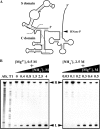Studies on Methanocaldococcus jannaschii RNase P reveal insights into the roles of RNA and protein cofactors in RNase P catalysis
- PMID: 18558617
- PMCID: PMC2475606
- DOI: 10.1093/nar/gkn360
Studies on Methanocaldococcus jannaschii RNase P reveal insights into the roles of RNA and protein cofactors in RNase P catalysis
Abstract
Ribonuclease P (RNase P), a ribonucleoprotein (RNP) complex required for tRNA maturation, comprises one essential RNA (RPR) and protein subunits (RPPs) numbering one in bacteria, and at least four in archaea and nine in eukarya. While the bacterial RPR is catalytically active in vitro, only select euryarchaeal and eukaryal RPRs are weakly active despite secondary structure similarity and conservation of nucleotide identity in their putative catalytic core. Such a decreased archaeal/eukaryal RPR function might imply that their cognate RPPs provide the functional groups that make up the active site. However, substrate-binding defects might mask the ability of some of these RPRs, such as that from the archaeon Methanocaldococcus jannaschii (Mja), to catalyze precursor tRNA (ptRNA) processing. To test this hypothesis, we constructed a ptRNA-Mja RPR conjugate and found that indeed it self-cleaves efficiently (k(obs), 0.15 min(-1) at pH 5.5 and 55 degrees C). Moreover, one pair of Mja RPPs (POP5-RPP30) enhanced k(obs) for the RPR-catalyzed self-processing by approximately 100-fold while the other pair (RPP21-RPP29) had no effect; both binary RPP complexes significantly reduced the monovalent and divalent ionic requirement. Our results suggest a common RNA-mediated catalytic mechanism in all RNase P and help uncover parallels in RNase P catalysis hidden by plurality in its subunit make-up.
Figures




Similar articles
-
Dissecting functional cooperation among protein subunits in archaeal RNase P, a catalytic ribonucleoprotein complex.Nucleic Acids Res. 2010 Dec;38(22):8316-27. doi: 10.1093/nar/gkq668. Epub 2010 Aug 12. Nucleic Acids Res. 2010. PMID: 20705647 Free PMC article.
-
Cooperative RNP assembly: complementary rescue of structural defects by protein and RNA subunits of archaeal RNase P.J Mol Biol. 2011 Aug 12;411(2):368-83. doi: 10.1016/j.jmb.2011.05.012. Epub 2011 Jun 12. J Mol Biol. 2011. PMID: 21683084 Free PMC article.
-
Fidelity of tRNA 5'-maturation: a possible basis for the functional dependence of archaeal and eukaryal RNase P on multiple protein cofactors.Nucleic Acids Res. 2012 May;40(10):4666-80. doi: 10.1093/nar/gks013. Epub 2012 Jan 31. Nucleic Acids Res. 2012. PMID: 22298511 Free PMC article.
-
Sequence Analysis and Comparative Study of the Protein Subunits of Archaeal RNase P.Biomolecules. 2016 Apr 20;6(2):22. doi: 10.3390/biom6020022. Biomolecules. 2016. PMID: 27104580 Free PMC article. Review.
-
Structural basis for activation of an archaeal ribonuclease P RNA by protein cofactors.Biosci Biotechnol Biochem. 2017 Sep;81(9):1670-1680. doi: 10.1080/09168451.2017.1353404. Epub 2017 Jul 17. Biosci Biotechnol Biochem. 2017. PMID: 28715256 Review.
Cited by
-
Functional implication of archaeal homologues of human RNase P protein pair Pop5 and Rpp30.J Biochem. 2016 Jan;159(1):31-40. doi: 10.1093/jb/mvv067. Epub 2015 Jul 7. J Biochem. 2016. PMID: 26152732 Free PMC article.
-
Interactions of a Pop5/Rpp1 heterodimer with the catalytic domain of RNase MRP.RNA. 2011 Oct;17(10):1922-31. doi: 10.1261/rna.2855511. Epub 2011 Aug 30. RNA. 2011. PMID: 21878546 Free PMC article.
-
Cryo-electron microscopy structure of an archaeal ribonuclease P holoenzyme.Nat Commun. 2019 Jun 13;10(1):2617. doi: 10.1038/s41467-019-10496-3. Nat Commun. 2019. PMID: 31197137 Free PMC article.
-
Dissecting functional cooperation among protein subunits in archaeal RNase P, a catalytic ribonucleoprotein complex.Nucleic Acids Res. 2010 Dec;38(22):8316-27. doi: 10.1093/nar/gkq668. Epub 2010 Aug 12. Nucleic Acids Res. 2010. PMID: 20705647 Free PMC article.
-
Purification, reconstitution, and mass analysis of archaeal RNase P, a multisubunit ribonucleoprotein enzyme.Methods Enzymol. 2021;659:71-103. doi: 10.1016/bs.mie.2021.07.006. Epub 2021 Sep 25. Methods Enzymol. 2021. PMID: 34752299 Free PMC article.
References
-
- Guerrier-Takada C, Gardiner K, Marsh T, Pace NR, Altman S. The RNA moiety of ribonuclease P is the catalytic subunit of the enzyme. Cell. 1983;35:849–857. - PubMed
-
- Jarrous N, Altman S. Human ribonuclease P. Methods Enzymol. 2001;342:93–100. - PubMed
-
- Evans D, Marquez SM, Pace NR. RNase P: interface of the RNA and protein worlds. Trends Biochem. Sci. 2006;31:333–341. - PubMed
-
- Gopalan V, Altman S. Gesteland RF, Cech TR, Atkins JF The RNA World. Cold Spring Harbor, NY: CSH Laboratory Press; 2006. Chapter 6.1 (only online at http://rna.cshl.edu)
Publication types
MeSH terms
Substances
Grants and funding
LinkOut - more resources
Full Text Sources
Miscellaneous

